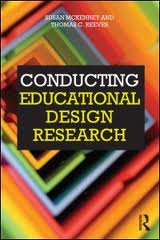
Educational Design Research (EDR) looks like Action Research (AR) by another name. On first encounter it’s not easy to tell them apart. EDR aims to produce useable knowledge. AR to produce actionable knowledge. Both are essentially practical rather than theoretical; aiming to find solutions for real world problems. Both take time. They share an action reflection reaction process which can’t be rushed. It’s as long as it takes. No short cuts allowed which conflicts with publish or perish imperatives driving academic research. No quick wins which is good because reflection on practice can’t be rushed and if research cuts corners it isn’t worth it.
So what about their methodologies? An ED Researcher typically identifies a problem and uses a framework of analysis (to understand the problem), design (to literature review and create a potential solution) and evaluation (for testing and revising the design accordingly). An Action Researcher identifies a problem, develops a potential solution, practices, evaluates and reflects before revising and repeating. The theory generated by both is based on empirical rather than hypothetical practice. They look so similar you have to dig deep to separate them.
Digging deeper I find a paper by Wang & Hannafin, 2005, saying EDR ‘…advances instructional design research theory and practice as iterative, participative and situational rather than processes ‘owned by operated’ by instructional designers.’ So rather than designing instructional techniques and methods in isolation, EDR is a collaborative process taking into account the real world environment of the classroom. The teacher identifies the problem. Calls on the ED researcher. They devise the research project in collaboration rather than isolation. Sounds promising. Especially if it narrows the divide between the technology and the pedagogy. Techies and teachers should walk a mile in each other’s shoes. I’m sure it would help.
Digging deeper still, I fins a paper by Reeves, Herrington, & Oliver, 2005, which claims EDR emphasises content and pedagogy rather than technology. If your research involves educational design and it’s using technology for education, I’m not sure how you can separate them. The original problem of elearning remains i.e. rifts between the technology and the teacher. I can only think the authors are dismissing the technology because they’re so familiar with it, they don’t see it an an issue whereas for most teachers, it’s the technology itself which is the barrier.
It’s possible this is pedantic rather than paradigmatic difference or comes down to continental linguistics like you say instructional I say educational. We have virtual learning environments, you have technical solutions. Like Blackboard Learn™ is an education technology platform and we call it a vle.
This is fine detail but research is as much about the small as the large and the similarities and differences between EDR and AR are relevant. While both offer academically rigorous paradigms for the empirical study of teaching practice, one is research into your own teaching practice while the other is research into the teaching practice of others.
So by this definition I am an AR not a EDR even though both address existing significant problems (rather than research for its own sake), define pedagogical outcomes, develop learning solutions and emphasise interaction and community (Reeves, Herrington, & Oliver, 2005: 110). The primary difference for me, I think, is AT can address any social situation whereas I’m applying the principles to educational practice and this reinforces the parallels with EDR. It’s necessary to spend time interrogating the differences and similarities. Part of the process is finding connections and using them to highlight and confirm my research questions. In the time stressed environments we all work in, I think this has been time well spent.
————————————————————————————————————————–
Reeves, T. C., Herrington, J., & Oliver, R. (2005). Design research: A socially responsible approach to instructional technology research in higher education. Journal of Computing in Higher Education, 16(2), 97-116.
Wang, F., & Hannafin, M. J. (2005). Design-based research and technology-enhanced learning environments.Educational Technology Research and Development, 53(4), 5-23.
